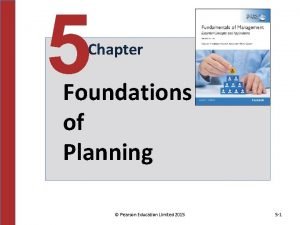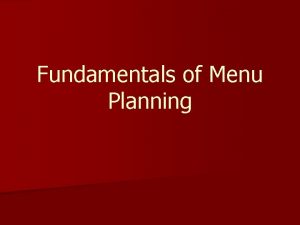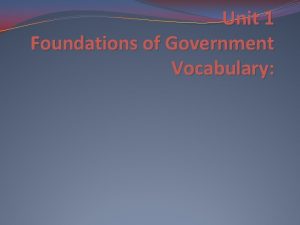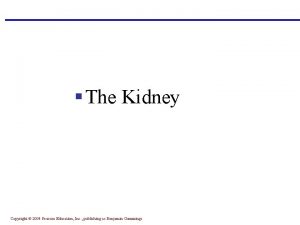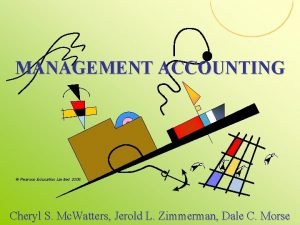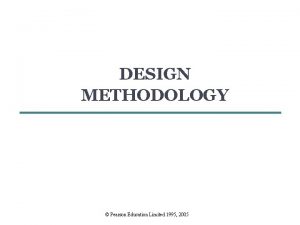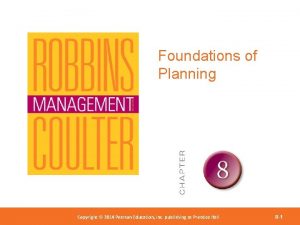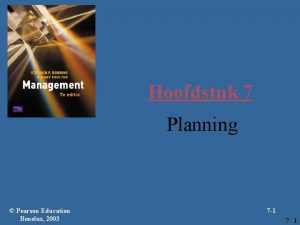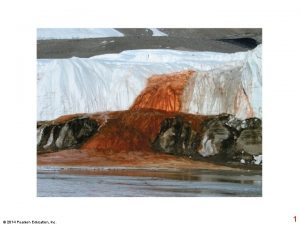Chapter 7 FOUNDATIONS OF PLANNING 2003 Pearson Education





























- Slides: 29

Chapter 7 FOUNDATIONS OF PLANNING © 2003 Pearson Education Canada Inc. 7. 1

LEARNING OBJECTIVES • You should be able to: – Define planning – Explain why managers plan – Describe what role goals play in planning – Distinguish among the different types of plans – Tell how goals are established – Describe the characteristics of well-designed goals © 2003 Pearson Education Canada Inc. 7. 2

LEARNING OBJECTIVES (continued) • You should learn to: – Identify three contingency factors in planning – Explain the approaches to developing plans – Discuss the criticisms of planning – Describe what it takes to effectively plan in a dynamic environment © 2003 Pearson Education Canada Inc. 7. 3

WHAT IS PLANNING? • Planning – – – Involves defining the organization’s goals, establishing an overall strategy for achieving those goals, and developing a comprehensive set of plans to integrate and coordinate organizational work Informal planning - nothing is written down Formal planning - written © 2003 Pearson Education Canada Inc. 7. 4

WHY DO MANAGERS PLAN? • Purposes of Planning – Planning is the primary management function that establishes the basis for all other management functions as it gives direction – Planning establishes coordinated effort – Planning reduces uncertainty – Planning reduces overlapping and wasteful activities – Planning establishes goals and standards used in controlling © 2003 Pearson Education Canada Inc. 7. 5

WHY DO MANAGERS PLAN? (continued) • Planning and Performance – – Generally speaking, formal planning is associated with higher profits Quality of the planning process and the appropriate implementation of the plans probably contribute more to high performance than does the extent of planning External environment may undermine the effects of formal planning Planning/performance relationship is influenced by the planning time frame © 2003 Pearson Education Canada Inc. 7. 6

HOW DO MANAGERS PLAN? • The Role of Goals and Plans in Planning – Goals - desired outcomes • provide direction for all management decisions • represent the criteria against which actual work accomplishments can be measured – Plans - outline how goals are going to be met © 2003 Pearson Education Canada Inc. 7. 7

STATED OBJECTIVES FROM LARGE COMPANIES (Exhibit 7. 1) © 2003 Pearson Education Canada Inc. 7. 8

HOW DO MANAGERS PLAN? (continued) • The Role of Goals and Plans in Planning (continued) – Types of Goals • • all organizations have multiple objectives no single measure can evaluate whether an organization is successful stated goals - official statements of the organization’s goals real goals - those goals that an organization actually pursues © 2003 Pearson Education Canada Inc. 7. 9

HOW DO MANAGERS PLAN? (continued) • The Role of Goals and Plans in Planning (continued) – Types of Plans • strategic plans - apply to the entire organization – – • establish organization’s overall goals seek to position the organization in terms of its environment operational plans - specify the details of how the overall goals are to be achieved – tend to cover short time periods © 2003 Pearson Education Canada Inc. 7. 10

TYPES OF PLANS Breadth Time Frame Strategic Long term Operational Short term © 2003 Pearson Education Canada Inc. Specificity Frequency of Use Directional Specific Single use Standing 7. 11

HOW DO MANAGERS PLAN? (continued) • The Role of Goals and Plans in Planning (continued) – Types of Plans (continued) • long-term plans - time frame beyond three years • short-term plans - cover one year or less • specific plans - clearly defined with little room for interpretation • directional plans - flexible plans that set out general guidelines © 2003 Pearson Education Canada Inc. 7. 12

SPECIFIC VERSUS DIRECTIONAL PLANS (Exhibit 7. 3) © 2003 Pearson Education Canada Inc. 7. 13

HOW DO MANAGERS PLAN (continued) • The Role of Goals and Plans in Planning (continued) – Types of Plans (continued) • • single-use plans - one-time plans specifically designed to meet the needs of a unique situation standing plans - ongoing plans that provide guidance for activities performed repeatedly © 2003 Pearson Education Canada Inc. 7. 14

HOW DO MANAGERS PLAN (continued) • Establishing Goals – Approaches to Establishing Goals • traditional goal setting - overall goals established at the top of the organization – overall goals broken down into sub-goals for each level of the organization • network of goals creates a means-ends chain – sub-goals constrain subordinates’ behaviour • assumes that top managers know what is best for the organization © 2003 Pearson Education Canada Inc. 7. 15

TRADITIONAL OBJECTIVE SETTING (Exhibit 7. 4) Top Management’s Objective Division Manager’s Objective Department Manager’s Objective Individual Employee’s Objective © 2003 Pearson Education Canada Inc. “We need to improve the company’s performance” “I want to see a significant improvement in this division’s profits” “Increase profits, regardless of the means” “Don’t worry about quality: just work fast” 7. 16

HOW DO MANAGERS PLAN? (continued) • Establishing Goals (continued) – Approaches to Establishing Goals (continued) • management by objectives (MBO) - specific performance goals are jointly determined by employees and their managers – progress toward accomplishing these goals is periodically reviewed – rewards are allocated on the basis of this progress – MBO consists of four elements • goal specificity • participative decision making • explicit time period • performance feedback © 2003 Pearson Education Canada Inc. 7. 17

STEPS IN A TYPICAL MBO PROGRAM (Exhibit 7. 5) © 2003 Pearson Education Canada Inc. 7. 18

HOW DO MANAGERS PLAN (continued) • Establishing Goals (continued) – Approaches to Establishing Goals (continued) • management by objectives (continued) – increases employee performance and organizational productivity – problems with MBO • can be useless in times of dynamic change • overemphasis on personal rather than organizational goals • may be viewed simply as an annual exercise in paperwork © 2003 Pearson Education Canada Inc. 7. 19

HOW DO MANAGERS PLAN? (continued) • Establishing Goals (continued) – Characteristics of Well-Designed Goals • • • written in terms of outcomes measurable and quantifiable clear as to a time frame challenging but attainable written down communicated to all organization members who need to know the goals © 2003 Pearson Education Canada Inc. 7. 20

HOW DO MANAGERS PLAN? (continued) • Establishing Goals (continued) – Steps in Goal Setting • • • 1 - Review the organization’s mission 2 - Evaluate available resources 3 - Determine the goals individually or with input from others 4 - Write down the goals and communicate them to all who need to know them 5 - Review results and whether goals are being met © 2003 Pearson Education Canada Inc. 7. 21

HOW DO MANAGERS PLAN? (continued) • Developing Plans – Contingency Factors in Planning • level in the organization – operational planning dominates managers’ planning efforts at lower levels – strategic planning more characteristic of planning at higher levels © 2003 Pearson Education Canada Inc. 7. 22

PLANNING IN THE HIERARCHY OF ORGANIZATIONS (Exhibit 7. 7) Top Executives Strategic Planning Middle-Level Managers Operational Planning © 2003 Pearson Education Canada Inc. First-Level Managers 7. 23

HOW DO MANAGERS PLAN? (continued) • Developing Plans (continued) – Contingency Factors in Planning (continued) • degree of environmental uncertainty • length of future commitments – commitment concept - plans should extend far enough to meet those commitments made when the plans were developed © 2003 Pearson Education Canada Inc. 7. 24

HOW DO MANAGERS PLAN? (continued) • Developing Plans (continued) – Approaches to Planning • traditional, top-down approach – planning done by top managers – formal planning department - specialists whose sole responsibility is to help to write organizational plans – plans flowed down to lower levels – most effective if plan is a workable document used by organizational members for direction and guidance © 2003 Pearson Education Canada Inc. 7. 25

HOW DO MANAGERS PLAN? (continued) • Developing Plans (continued) – Approaches to Planning (continued) • inclusive approach – – – employees at each level develop plans suited to their needs employees acquire greater sense of the importance of planning when they participate in the process plans more likely to be used in directing and coordinating work © 2003 Pearson Education Canada Inc. 7. 26

CONTEMPORARY ISSUES IN PLANNING • Criticisms of Planning 1. 2. 3. Planning may create rigidity • unwise to force a course of action when the environment is fluid Plans can’t be developed for a dynamic environment • flexibility required in a dynamic environment • can’t be tied to a formal plan Formal plans can’t replace intuition and creativity • mechanical analysis reduces the vision to some type of programmed routine © 2003 Pearson Education Canada Inc. 7. 27

CONTEMPORARY ISSUES IN PLANNING (continued) • Criticisms of Planning (continued) 4. Planning focuses managers’ attention on today’s competition, not on tomorrow’s survival plans concentrate on capitalizing on existing business opportunities • hinders managers who consider creating or reinventing an industry 5. Formal planning reinforces success, which may lead to failure • success may breed failure in an uncertain environment • © 2003 Pearson Education Canada Inc. 7. 28

CONTEMPORARY ISSUES IN PLANNING (continued) • Effective Planning in Dynamic Environments – develop plans that are specific, but flexible – recognize that planning is an ongoing process – change directions if environmental conditions warrant – stay alert to environmental changes © 2003 Pearson Education Canada Inc. 7. 29
 Copyright 2003 pearson education inc
Copyright 2003 pearson education inc Pearson education 2011
Pearson education 2011 2011 pearson education inc
2011 pearson education inc Pearson education inc publishing as pearson prentice hall
Pearson education inc publishing as pearson prentice hall Pearson education inc. 2012
Pearson education inc. 2012 2008 pearson prentice hall inc
2008 pearson prentice hall inc Pearson education limited 2015
Pearson education limited 2015 Purpose of menu planning
Purpose of menu planning Ewles and simnett planning model 2003
Ewles and simnett planning model 2003 Ewles and simnett planning model
Ewles and simnett planning model Ewles and simnett planning model
Ewles and simnett planning model Pearson vue ceo
Pearson vue ceo Educational pearson pearson times
Educational pearson pearson times Foundations of a healthy relationship
Foundations of a healthy relationship Chapter 6 skills for healthy relationships
Chapter 6 skills for healthy relationships Chapter 2 foundations of resident care
Chapter 2 foundations of resident care Foundation of individual behavior
Foundation of individual behavior Guided reading activity foundations of government lesson 1
Guided reading activity foundations of government lesson 1 Chapter 4 foundations background to american history
Chapter 4 foundations background to american history Introduction to personal finance answers
Introduction to personal finance answers Chapter 1 foundations of government vocabulary
Chapter 1 foundations of government vocabulary Chapter 1: foundations of government pdf
Chapter 1: foundations of government pdf Foundations of government (chapter 1 test form a)
Foundations of government (chapter 1 test form a) Pearson education
Pearson education 2004 pearson education benjamin cummings
2004 pearson education benjamin cummings Pearson education limited 2008
Pearson education limited 2008 Nitrogen cycle pearson education
Nitrogen cycle pearson education Pearson education limited 2005
Pearson education limited 2005 2018 pearson education inc
2018 pearson education inc Pearson education ltd
Pearson education ltd






